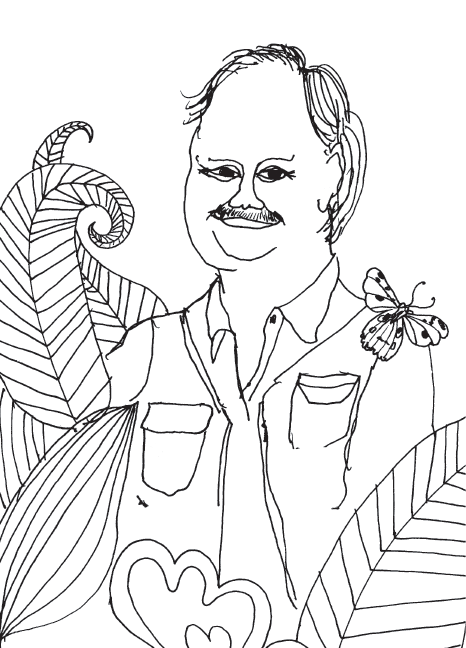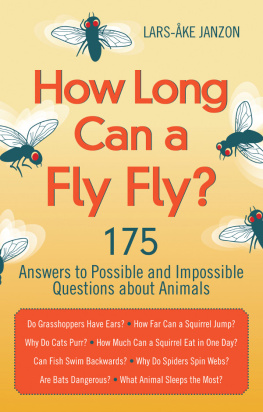All Rights Reserved. No part of this book may be reproduced in any manner without the express written consent of the publisher, except in the case of brief excerpts in critical reviews or articles. All inquiries should be addressed to Sports Publishing, 307 West 36th Street, 11th Floor, New York, NY 10018.
Skyhorse Publishing books may be purchased in bulk at special discounts for sales promotion, corporate gifts, fund-raising, or educational purposes. Special editions can also be created to specifications. For details, contact the Special Sales
Department, Sports Publishing, 307 West 36th Street, 11th Floor, New York, NY 10018 or info@skyhorsepublishing.com.
Skyhorse and Skyhorse Publishing is a registered trademark of Skyhorse Publishing, Inc., a Delaware corporation.
Library of Congress Cataloging-in-Publication Data is available on file.
ON DUTY
BIOLOGIST WITH ALL
THE ANSWERS !
When Lars-ke Janzon turns on his cellphone in his home in Stockholm, it sometimes happens that the phone starts ringing at six o'clock in the morning. Like when the dreaded Black Widow spider was found a few years ago in a garage a little north of the city. At times like that he is flooded with calls from radio and newspapers, and invited to every morning news talk show on TV.
Lars-ke Janzon is an On Duty Biologist at the Museum of Natural History in Sweden, and is constantly prepared to answer everyone's questions about animals and nature. If duty calls he will not hesitate to participate in a live radio show from his cellphone on the bus going to work. Luckily Lars-ke is not someone who is easily stressed. He is a cheerful and friendly person with a twinkle in his eye and is everyone's favorite on both radio and television.
The On Duty Biologist has an office in the southern wing of the museum. As soon as you enter the room you understand that a constant quest for answers to nature's mysteries is taking place: The high walls are covered by bursting bookshelves with titles like The World of Fossils,

Animal Records, Sharks and Rays, Die Wildbienen, Animals' Poison, and Carl von Linns Swedish Flora.
On the table amidst stacks of The Entomological Journal, The Swedish Botanical Journal, and Our World of Birds, you find plastic bags with parts of green plantssent by someone who wanted to know what sort of exotic plant was growing in the backyardand a see-through plastic box with beechnuts, oak, a number of real chestnuts, and other things for a curious biologist. A few red and slightly frail geraniums are shining in the window, and on the table in front of them stands a stereo microscope.
I used it just the other day, to study a little insect that someone found in their bathroom and wanted to know if it was a pest. I only had a few parts, like some of the head and the middle of the body, but I could still see that it was a small Heteroptera, nothing to worry about! Janzon announced energetically.
So what is the best part of being an On Duty Biologist?
The diversity, Lars-ke answers instantly. Diversity in regard to the questions I receive but also the diversity of people I meet in emails and on the phone. Most of all the children, from preschool age to middle school, not yet stifled by school and therefore still thinking in ways that could be considered as strange. All the difficult questions are asked by children!
For example, How big is the mouth of a worm? and How long is the tongue of a worm?
Luckily I have a colleague who is an expert at worms...
What few people know is that the Museum of Natural History in Stockholm not only holds exhibitions and stuffed animals, it is also a big research institution. Of the roughly 250 employees, almost 200 conduct research, including the collections and administration departments. Tat is why Lars-ke, as a newly graduated biologist in the fall of 1972, started out taking care of the insect collection in the entomological section. Ten a few years of moving around the different departments in the museum followed; he boiled seal skulls for the collections of skeletons, made pollen forecasts, was the editor of the journal Fauna and Flora , and produced exhibitions before he returned to focus on entomology to receive a PhD degree. In 1984 he defended a thesis about Hymenoptera, who live of of maggots in potted flowers.
But after a while it started feeling somewhat introverted; we were the only three people in the world that were experts on the species in a relatively small group within the big Hymenoptera parasitic genus Pteromalus.
That is why he did not hesitate when he was offered the job as an On Duty Biologist almost ten years ago. Troughout the years he has answered more than 100,000 questions from the public, not including the ones from radio, television, and newspapers.
Suddenly Lars-ke's cellphone beeps: GREAT EGRET in HASSKEHOLM the display reads. Lars-ke is an ornithologist and a member of Club 300, for those who enjoy seeing many and rare bird species. The club has an alarm system so that the members can quickly communicate with each other when a rare bird is spotted somewhere in the country.
Lars-ke does not want to call himself a professional, and does not know exactly how many species of birds he has really seen. A little reluctantly, he admits that the number is probably close to 350. Although he rarely heads to the site himself, when the alarm goes of, it can be helpful for him to be aware of the sighting.
All of a sudden someone calls and ask about some strange bird they have seen. Ten I ask where they live and if it is nearby Hssleholmbingo!
The questions of the What was it that I saw? variety are becoming increasingly common in the On Duty Biologist's box of questions. As more and more people have access to a digital camera it is easier to take a photo to send in whenever you see something interesting, from a hairy larva, a new butterfly, or an unusual spider.
And it is a lot of fun! It is just those things we are good at here in the museum, our specialty is knowledge about species, kinship, and evolution.
Lars-ke Janzon was born in Malm, Sweden, but grew up in a Stockholm suburb. He became a field biologist early on, and the fascination with birds, insects, and plants has not lessened throughout the years. He admits that his passion for nature can be a burden for people around him when taking walks together; there is always something new to discover and study. To categorize even the most common bird can be a challenge, as its appearance varies depending on age, gender, time of year, and mating costume.
As an On Duty Biologist, Lars-ke has become one of the most well-known faces in the Museum of Natural History. Sometimes he feels like an actual celebrity. Such as when a young kid on his bicycle stops and asks him: Are you the person in Hjrnkontoret? And with a voice full of admiration exclaims: You have the answers to everythingyou are awesome!
















